Back to Journals » Drug, Healthcare and Patient Safety » Volume 12
Patient Safety Culture and Associated Factors Among Health Care Providers in Bale Zone Hospitals, Southeast Ethiopia: An Institutional Based Cross-Sectional Study
Authors Kumbi M, Hussen A , Lette A, Nuriye S, Morka G
Received 13 December 2018
Accepted for publication 21 December 2019
Published 10 January 2020 Volume 2020:12 Pages 1—14
DOI https://doi.org/10.2147/DHPS.S198146
Checked for plagiarism Yes
Review by Single anonymous peer review
Peer reviewer comments 2
Editor who approved publication: Dr Hemalkumar B Mehta
Musa Kumbi, 1 Abduljewad Hussen, 1 Abate Lette, 1 Shemsu Nuriye, 2 Geroma Morka 3
1Department of Public Health, Goba Referral Hospital, Madda Walabu University, Goba, Ethiopia; 2Department of Public Health, College of Health Science and Medicine, Wolayta Sodo University, Sodo, Ethiopia; 3Department of Nursing, Goba Referral Hospital, Madda Walabu University, Goba, Ethiopia
Correspondence: Abate Lette
Department of Public Health, Goba Referral Hospital, Madda Walabu University, PO Box 274, Goba, Ethiopia
Email [email protected]
Introduction: Patient safety is a serious global public health issue and a critical component of health care quality. Unsafe patient care is associated with significant morbidity and mortality throughout the world. In Ethiopia health system delivery, there is little practical evidence of patient safety culture and associated factors. Therefore, this study aims to assess patient safety culture and associated factors among health care providers in Bale Zone hospitals.
Methods: A facility-based cross-sectional study was undertaken using the “Hospital Survey on Patient Safety Culture (HSOPSC)” questionnaire. A total of 518 health care providers were interviewed. Analysis of variance (ANOVA) was employed to examine statistical differences between hospitals and patient safety culture dimensions. We also computed internal consistency coefficients and exploratory factor analysis. Bivariate and multivariate linear regression analyses were performed using SPSS version 20. The level of significance was established using 95% confidence intervals and a p-value of < 0.05.
Results: The overall level of patient safety culture was 44% (95% CI: 43.3– 44.6) with a response rate of 93.2%. Factor analysis indicated that hours worked per week, participation in a patient safety program, reporting of adverse events, communication openness, teamwork within hospital, organizational learning and exchange of feedback about error were among factors that were significantly associated with the patient safety culture.
Conclusion: According to the Agency for Health Research and Quality, the overall classification of patient safety score and most of the scores related to dimensions were low. Hours worked per week, participation in a patient safety program, reporting of adverse events and most safety dimensions were found to be factors associated with patient safety culture. Well-designed patient safety interventions need to be integrated with organizational policies to address all dimensions of patient safety culture.
Keywords: patient safety culture, health care providers, Bale Zone hospitals
Introduction
Patient safety is a serious global public health issue which is defined as the prevention of harm to patients with an emphasis on the system of care delivery that prevents errors, learns from the errors that do occur and is built on a culture of safety that involves health care professionals, organizations, and patients. 1,11 Patient safety is a critical component of health care quality.2 Even though the estimates of the size of the problem are scarce, particularly in developing and transitional countries, it is likely that millions of patients worldwide suffer disabilities, injuries or death every year due to unsafe medical care.3
Patient safety culture has been defined as the values shared among organization members about what is important, their beliefs about how things operate in the organization, and the interaction of these within work unit and organizational structures and systems, which together produce behavioral norms in the organization that promote safety.4,5 Achieving a culture of safety requires an understanding of the values, beliefs, and norms about what is important in an organization and what attitudes and behaviors related to patient safety are expected and appropriate.6
Due emphasis should be given to addressing disparities in quality of care as the challenges of the current system may worsen if efforts fail to narrow the gaps. Quality and safety have been recognized as key issues in establishing and delivering accessible, effective and responsive health systems. The success of Ethiopia’s Health Sector Transformational Plan (HSTP) will mainly be measured by the quality of health service and how well-equitable health outcomes are achieved.7 Unsafe patient care is associated with significant morbidity and mortality rates throughout the world, much of which may be amenable to timely intervention.8 Globally, an estimated average of 10% of all inpatient admissions result in a degree of accidental patient harm, and it is estimated that up to 75% of these gaps in health care delivery are preventable.9
In developing countries, the probability of a patient being harmed in hospitals is high, with the risk of health care-associated infection as much as 20 times higher than in developed countries.10 The African Region is particularly challenged by a lack of constructive assessments, comprehensive policies and strategies for patient safety, and health systems in Africa are in massive need of rapid evolution.7 A study conducted in eight developing countries indicated that of the 15,548 records reviewed 8.2% showed at least one adverse event, with a range of 2.5% to 18.4% per country. Of those adverse events, 83% were preventable and 30% were associated with the death of the patients.11 According to a study done at Cairo University Hospitals, only 48.5% of the study participants reported the occurrence of patient safety events in their corresponding departments. The majority of respondents (79.3%) felt that errors are held against them and later kept in their files.12,27 Only 26.13% of studied nurses recorded high perceptions for overall patient safety culture. Two-third (77.90%) of respondents reported no adverse events during the last 6 months.13,28
In Ethiopia, the overall patient safety score was (46%) . The overall patient safety grade as rated by the participants was acceptable (58.4%) and poor (20.1%).14,16 Working hours, level of staffing, teamwork, communication openness, reporting an event, and exchange of feedback about error were associated with patient safety culture.15,20 Circumstantial evidence shows that almost all errors committed during patient treatment have been treated traditionally through blaming and shaming. In addition to this, most medical errors are not reported and/or are hidden. To our knowledge, little work has been done on patient safety culture in other parts of Ethiopia. As the level of patient safety culture varies from one area to the other, the levels of patient safety culture and contributing factors also vary from one context to the other. The main aim of this study is to assess the level of patient safety culture and verify associated factors in Bale Zone Hospitals, Southeast Ethiopia.
Methods and Materials
Study Design, Area and Period
A facility-based cross-sectional design was conducted from February 1 to February 30, 2017, in Bale Zone hospitals, in south-eastern Ethiopia. In this zone, there are four functional government hospitals (Goba, Robe, Ginnir, and Delomena Hospitals). The hospitals deliver health services in many specialty areas including gynecology and obstetrics, surgery, pediatrics and child health, internal medicine, ophthalmology, psychiatry, and dentistry. This study targets health care providers of hospitals, like physicians, dentists, nurses, ophthalmologists, health officers, midwives, psychiatrists, pharmacists, physiotherapists, environmental and occupational health practitioners, anesthetists, laboratory and radiology staff.
Inclusion Criteria
All health care providers who have worked at least for 6 months prior to data collection were included.
Exclusion Criteria
Health care providers that were on education, long-term training, and extended leave at the time of survey distribution were excluded.
Sample Size Determination and Techniques
According to the data gathered from Bale Zone hospitals, the total number of health care providers currently on the job for at least 6 months in the hospitals at the time of data collection was 556. Since the number of health care providers are manageable, all the health care providers fulfilling the inclusion criteria were included.
Data Collection Procedure and Tool
Data were collected by pretested and structured self-administered questionnaire. An English questionnaire was used as it is the main language of communication by professionals in Ethiopian hospitals. Data were collected by eight public health staff and supervised by four public health professionals with MPH degrees.
The Hospital Survey on Patient Safety Culture (HSOPSC) tool was adopted6 to collect data. The tool was designed to assess hospital staff opinions about patient safety issues, medical errors, and event reporting. It includes 42 items that measure 12 dimensions or composites of patient safety culture: ‘Communication openness’ (3 items), ‘Feedback and communication about errors’ (3 items), “Frequency of events reported” (3 items), “Handoffs and transitions” (4 items), “Management support for patient safety” (3 items),“Non-punitive response to error” (3 items), “Organizational learning–continuous improvement” (3 items), “Overall perceptions of patient safety” (4 items), “Staffing” (4 items), “Supervisor/manager expectations and actions promoting safety” (4 items), and “Teamwork across and within units” (4 items each). The response to each item in the questionnaire was assessed using a 5-point Likert scale of agreement (from 1: “Strongly disagree” to 5: “Strongly agree”) or frequency (from 1: “Never” to 5: “Always”). The HSOPSC included both positively and negatively worded items. There were also two single-item outcome variables: the overall patient safety grade (measured on a scale of “Excellent”, “Very good”, “Acceptable”, “Poor”, and “Failing”) and the number of events reported in the past 12 months. Background characteristics and systemic variables of participants included questions related to job category, type of hospital (teaching/referral, district), work experience (overall and in the current working area), work setting, working hours per week staff position, whether they have direct interaction with patients, tenure in their work area/unit, patient safety training, participation in safety program and adverse event reporting, etc.
Data Processing and Analysis
Data were checked, edited, coded, and entered into a database using Epi-info Version 7.00 and exported to Statistical Package for Social Science (SPSS) version 20 for further analysis.
The frequency distribution of all the variables was examined to check for data entry errors. Most of the variables were described using descriptive statistics. Negatively worded items were first reverse coded so that a higher score would indicate a more positive response.
The AHRQ6 recommends the use of “average positive” for calculating each item score. Percent positive is the proportion of positive responses (e.g. agree or strongly agree) to positively worded items or negative responses (e.g. disagree or strongly disagree) to negatively worded items. Composite scores were computed by adding the items within the composite scales and dividing by the total number of responses with non-missing values. We defined areas of strength as those responses for which 75% of the respondents answered positively; between 50% and 75% was considered an average response whereas areas requiring improvement were those responses that scored below 50%.6
To determine the reliability of the questionnaire, Cronbach’s alpha internal consistency test was used for each dimension and showed an acceptable level of internal consistency, i.e. Cronbach’s α = 0.80. Dimensions with Cronbach’s alpha values ≥0.6 were subjected to principal component analysis (PCA) (Table 1). The item deletion was done in order to ensure that the Cronbach’s alpha value for each composite was at least 6. Even though there was no effect on the overall reliability, exclusion of the item “we have enough staff to handle the workload” would result in the “staffing” dimension reliability increasing from 0.16 to 0.51. Also, an exclusion of the item “Hospital management seems interested in patient safety only after an adverse event happens” would result in the “hospital management support for patient safety” dimension reliability increasing from 0.41 to 0.82.
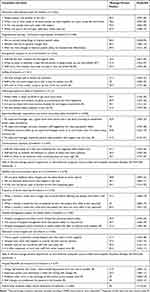 |
Table 1 Percent Average Positive Response for an Item-Level and Composite Scores at Bale Zone Hospitals, Southeast Ethiopia, 2017 (N=518) |
One way analysis of variance (ANOVA) was used to compare mean scores of dimensions across hospitals and post hoc tests were conducted to identify the differences when the ANOVAs were significant.
All assumptions of factor analysis were checked using Kaiser–Meyer–Olkin test and Bartlett’s test. Accordingly, the KMO value was 0.78 which means the data were appropriate for factor analysis. Barlett’s test of sphericity for the instrument showed sufficient inter-item correlations (χ2 = 5863; df = 465, p <0.001). Factor analysis was employed for Likert scale instruments to extract factor(s) representing each of the scales and to obtain factor scores. Factors with eigenvalues greater than one were considered in subsequent analyses. Factor scores were computed for the item identified to represent patient safety culture dimension scale by varimax rotation. Factor loadings greater than 0.40 indicate that an item is related or associated with a given factor and retain only factor leading ≥0.40.
Before fitting a linear regression model, first, the assumptions were checked. Accordingly, the assumption of linearity checked through scatter plot, normality checked by plotting histogram and P-P plots and homoscedasticity was checked by plotting scatter plot of standardized residuals against the standardized predicted values and all assumptions were satisfied. The Durbin Watson statistics was used to check the assumption of independence of errors and autocorrelations. Multicollinearity assumption was checked through tolerance and Variance Inflation Factor (VIF) and there was no evidence of Multicollinearity.
Simple linear regression analysis was performed, and variables with a p-value < 0.25 were exported to multivariable linear regression analysis. The significance level was declared at p-value<0.05. The categorical independent variables were entered as dummy variables. A beta coefficient with a 95% confidence interval was used to describe statistically significant variables. Enter method was employed to enter independent variables of all models.
Data Quality Management
To ensure the completeness, accuracy, and consistency of data collection, a discussion session was held each day of the data collection period. Thorough checking was done before receiving the filled questionnaires from each data collector. After their willingness to participate in the study, data collectors and supervisors were trained for 3-day about the questioner and how to administer it. The questionnaire was pre-tested in Dodola primary hospital on 5% of the staff (i.e. 20 health care providers) before data collection to check consistency; correction was taken by identifying potential problem areas and logistic plan for data collection was done.
Operational definition level of patient safety culture: measured by the health care workers' response on the HSOPSC questionnaire for the 12 patient safety culture dimensions (42 items) and was considered as representing an overall level of patient safety culture.

Composite scores were computed by summation of the items within the composite scales and dividing by the number of items.6
Ethical Consideration
Ethical approval was obtained from the research ethics committee of Goba Referral Hospital, Madda Walabu University. Official permission letters were obtained from the Bale Zone Health Department and respective hospitals. Written informed consent was obtained from individual participants. No personal identification or name was used, and participants had full right to participate or refuse participation in this study.
Results
Background Characteristics of Respondents
Five hundred eighteen health care providers were interviewed to yield a response rate of 93.2%. Three hundred one (58.1%) of the interviewed participants were males. The mean age of the respondents was 29.1 (SD of 5.1) years and the age of the study participants ranged from 22 to 48 years. Two hundred eighty-three (54.6%) of the respondents were married, while 222 (42.9%) were single. Concerning educational status, 225 (43.4%) of the respondents held a bachelor's degree. Professionally, 225 (43.4%) of the respondents were nurses and 112 (21.6%) of respondents were working in the Gynecology& Obstetrics unit. A majority of the respondents [382 (73.7%)] had work experience of less than or equal to 5 years. Also, 514 (96.3%) respondents had direct interaction or contact with the patients and 388 (74.9%) of the respondents had not received any training on patient safety. Three hundred thirty-five (64.7%) of the respondents reported that hospital management blame them when medical errors happened (Table 2).
 |
Table 2 Background Characteristics and Systemic Factors of Participants at Bale Zone Hospitals, Southeast Ethiopia, 2017 (N=518) |
Patient Safety Culture Dimensions
In this study, the overall level of patient safety culture was 44% (95% CI: 43.3–44.6) and the 12 patient safety culture dimensions ranged from 30.5% to 73.2%. The dimension with the highest average percentage positive responses was “teamwork within unit” (73.4%) while the two lowest average percentage positive responses were “management support for patient safety“ (30.5%) and “non-punitive response to error” (31.2%). All composite scores of dimensions were less than 50% except for “Organizational learning–continuous improvement” (66.7%) and “Teamwork within units” (73.4%) (Table 3).
 |
Table 3 Patient Safety Culture Composite Level Results of Bale Zone Hospitals, Southeast Ethiopia, 2017(N=518) |
Patient Safety Culture Items
Our study revealed the positive response rate for each of the items ranged from 22% to 85%. The highest positive response rate of the items was “People support one another in this unit” (82.2%), while the lowest positive response rate of the item was ‘We have enough staff to handle the workload (27.2%). Altogether, there were 24 items (of 41 safety culture items) with less than 50% of the average positive scores (Table 1).
Patient Safety Grade and Number of Event Reporting
Overall, 64 (12.4%) and 152 (29.3%) of the respondents rated the patient safety grade as excellent and poor, respectively (Figure 1).
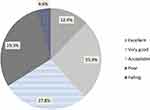 |
Figure 1 Patient safety grade among participants at Bale zone hospitals, southeast Ethiopia. |
The majority, 453 (87.4%) of respondents never reported any event in their hospital over the past 12 months (Figure 2).
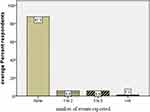 |
Figure 2 Average percentages of self-reporting events in the past 12 months. |
Factors Associated with Patient Safety Culture
In the first model, the effects of the respondent’s characteristics and some systemic factors of patient safety culture were assessed. In this model, variables such as physician category of staff position, hours worked per week, primary work area (surgery and pharmacy), participation in patient safety program, and adverse event reported showed an association (Table 4).
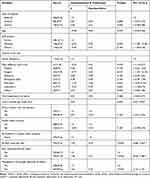 |
Table 4 Association of Background Characteristics of Respondents and Systemic Factors with Patient Safety Culture at Bale Zone Hospitals, Southeast Ethiopia, 2017 (N=518) |
Association Between Dimension of Safety and Level of Patient Safety Culture
In the second model, patient safety culture factor scores were included and tested the association on patient safety culture. Items with low reliability coefficients (non-punitive response to error, staffing and overall perceptions of safety) were excluded from the analysis. All composite scores were highly associated with the level of patient safety culture (P-value <0.001) and also selected for the final model (Table 5).
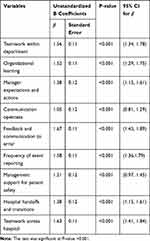 |
Table 5 Association Between Dimensions of Patient Safety Score and Level of Patient Safety Culture at Bale Zone Hospitals, Southeast Ethiopia, 2017 (N=518) |
The multivariable analysis model explained 75% of the variance in the patient safety culture. Multivariate analysis showed that Physician profession, hours worked per week, participation in patient safety program, adverse event reported, teamwork within hospital, organizational learning, communication openness, frequency of event reporting, feedback & communication, management support for patient safety, teamwork across hospital and hospital handoffs and transitions were found to be significantly associated with the patient safety culture (Table 6).
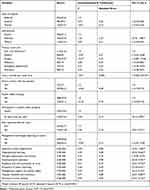 |
Table 6 Factors Associated with Patient Safety Culture, Using Multivariate Linear Regression Analysis, at Bale Zone Hospitals, Southeast Ethiopia, 2017 (N=518) |
Discussion
This study assessed the current status of patient safety culture in Bale Zone hospitals using the HSOPSC instrument. The present study revealed that the overall positive response rate for all dimensions of the HSOPSC survey showed that the hospitals had poor/low patient safety culture as well as areas with the potential for improvement and some areas that require urgent improvements. The overall level of patient safety culture of this study is comparable to the findings from Jimma Zone, Amhara region, Iran and India.12–15 However, the present study scored lower results when compared with the findings from local study SNNP16 and other developing countries like China, Lebanon, Oman, Saudi Arabia, Taiwan, and Yemen, respectively.17–20 This possible explanation for the difference might be due to the differences in organizational behavior between countries. Those countries might have better management values, organizational commitments, leadership and relationships within hospital staff. Other possible reasons might be due to high economic development and those countries which had initiated patient safety issue early compared to our country.15
None of the patient safety culture dimension composites score fits the criteria for areas of strength as per the guideline of HSOPSC. This also showed a severe deficit of patient safety culture in the studied hospitals. This is not surprising given the tremendous work and emphasizes on universal health care coverage, and that interest in quality is only a recent focus of attention. Despite significant improvements in health care services, issues related to quality and safety have been inconsistently integrated into the Ethiopian health care system but, recently, the government ratified strategies for improving quality nationwide in the next 5 years.6,29
In this study “teamwork within department” and “organizational learning” dimensions were area of highest average positive response rate. This indicates respondents are positive in supporting one another, working together as a team and doing things to improve patient safety. This result is concordant with the finding from Jimma zone, Amhara region, Kuwait, Chinese, Lebanese, Oman, Saudi hospitals, Taiwanese and Yemen.14,15,17–21
Our study revealed that almost all patient safety culture dimensions suggested areas with potential for improvement. This finding highlights deficiencies in almost all patient safety culture dimensions and indicates the presence of low patient safety practice in the study area. The composites with the lowest average percent positive responses were ‘Management support for patient safety “and ‘non punitive response to error’ with average positive response rate. This finding suggests health care workers in this study area feel that hospital management did not provides a conducive work climate that promotes patient safety and further that their mistakes and event reports are held against them and that mistakes are kept in their personal file. A similar finding was also observed in studies done in Jimma zone, Northern Ethiopia, Tunisia, Oman, India, Sri lanka, and Kuwait14,15,18,22.,23 but received a higher rating in Iran.13
In this study, only 12.6% of respondents within hospitals reported at least one event in their hospital over the past 1 year. This finding is lower than reports from Amhara region hospitals, according to which two-thirds of health care staffs reported at least one event, Jimma zone, SNNP hospitals, Lebanon, Saudi Arabia, and Iran.14–16,24,25 In order for a patient safety program to be, successful, strong leadership is needed. When leadership and management are committed to a culture of safety, the whole organization will follow and thus disclosing events and finding their root causes become an organizational process.
The present study revealed variations in patient safety culture dimensions across hospital in terms of ‘teamwork within hospital departments, “organizational learning”, “staffing”, “Perception of patient safety”, “feedback and communication about error”, “hospital management support for patient safety”, ‘teamwork across hospital departments, and ‘hospital handoffs and transitions’. Similar findings were reported from a study conducted at Jimma Zone hospitals and SNNP hospitals for most of the dimensions except for ‘Perception of patient safety’, feedback and communication about error and staffing which is the same across the hospitals.15
Our study indicated that hours worked per week, participation in patient safety program, adverse event reported, teamwork within hospital, communication openness, feedback, and communication when error occurred were found to be significantly associated with the patient safety culture. Similar findings were reported also from studies conducted at Jimma Zone hospitals.15,26 Also, dimensions like organizational learning, frequency of event reporting, management support for patient safety, teamwork across hospital, and hospital handoffs and transitions were predictors of patient safety culture. This result was not consistent with other studies.15,16 This might be due to the differences in the study settings and time.
The findings presented in this study can act as a basis to inform stakeholders in hospitals and initiate them to develop acceptable standards for patient safety system and implement interventions targeted to reduce the impact of these factors on the quality of hospital care are needed. In order to institutionalize improvement of patient safety culture in health systems, it is critical to ensure that policies, organizations, procedures, and resources for health service quality improvement and patient safety are aligned and integrated. Hospital management should be trained in patient safety culture assessment and involved in hospital walking rounds to communicate and build awareness of the staff on dimensions of patient safety culture.
A limitation of this study was that in addition to the cross-sectional design, perceptions of other administrative bodies were not included. Even though honestly explaining the objective and significance of the study was tried to minimize the effect, the possibility of under- or over-reporting could not be ruled out. Although the internal consistency of the survey was suitable, the reliability analysis of individual constructs identified dimensions with lower than adequate levels of reliability (alpha <0.6). Finally, the HSPOC as a patient safety measure might not explicitly evaluate safety issues that would arise as a result of resource limitations, such as infrastructure.
Conclusion
According to the classification of Agency for Health Research and Quality (AHRQ), the overall level of patient safety score and most of the scores related to dimensions were lower than the recommended standard. The trend of reporting adverse events or errors in hospitals is poor. Most dimensions of the patient safety culture revealed significant differences in their score across hospitals. Hours worked per week, participation in patient safety program, adverse event reported, and most patient safety dimensions were factors that compromise overall patient safety culture. Based on this finding, well-designed patient safety interventions are needed to be integrated with organizational policies, particularly the pressing need to address all dimensions of patient safety culture. A further study on the perception of other administrative bodies on patient safety culture is recommended.
Abbreviations
ADR, adverse drug reaction; ANOVA, one-way analysis of variance; AHRQ, Agency for Health Research and Quality; CI, confidence interval; FMOH, Federal Ministry of Health; HSOPSC, Hospital Survey on Patient Safety Culture; HSTP, Health Sector Transformation Plan; KMO, Kaiser–Meyer–Olkin test; PCA, principal component analysis; SD, standard deviation; SNNP, Southern nation, nationalities of Ethiopia; SPSS, Statistical Package for Social Science; VIF, variance inflation factor; WHO, World Health Organization.
Ethics Approval and Informed Consent
The study was performed by interviewing health care providers of hospitals after an ethical consent was obtained from Madda Walabu University ethical clearance committee and individual written, informed consent was obtained from the study participants.
Data Sharing Statement
The data will be made available upon request.
Author Information
MK is a lecturer and an academic and research coordinator at Madda Walabu University, AH is a lecturer and head of public health department at Madda Walabu University, AL and GM are lecturers at Madda Walabu University, and SN is a lecturer at Wolayta Sodo University.
Acknowledgments
We are grateful to Madda Walabu University for supporting this study. We are also very grateful to Dr. David Allison for his support regarding the English language editing service.
Author Contributions
All authors made substantial contributions to conception and design, acquisition of data or analysis and interpretation of data; took part in drafting the article or revising it critically for important intellectual content; gave final approval of the version to be published; and agree to be accountable for all aspects of the work.
Disclosure
The authors declare that they have no competing interests in this work.
References
1. Euro Med. Patient safety: a global public health issue and a concern for Europe. Lunch Debate, MedTech Forum. 2008.
2. Aiken LH. Improving patient safety: the link between nursing and quality of care. Res Profile. 2005;12:1–4
3. World Health Organization (WHO). African Partnerships for Patient Safety. Geneva: World Health Organization (WHO); 2009.Available from: https://apps.who.int/iris/bitstream/handle/10665/44189/9789241598545_eng.pdf;jsessionid=86DFE1015888AF1DD60E549E1D157A07?sequence=1. Accessed 10 December 2016.
4. Singer S, Lin S, Falwell A, Gaba D, Baker L. Relationship of safety climate and safety performance in hospitals. Health Serv Res. 2009;44(2):399–421.
5. World Health Organization (WHO). Human factors in patient safety; review of topics and tools; report for methods and measures. Working Group of WHO Patient Safety. 2009.
6. Sorra J, Nieva V Hospital survey on patient safety culture. (Prepared by Westat, under contract no. 290-96-0004). AHRQ publication no. 04–0041. 2004; Rockville: Available from: http://www.ahrq.gov/professionals/qualitypatientsafety/patientsafetyculture/hospital/index.html.
7. World Health Organization (WHO). Guide for Developing National Patient Safety Policy and Strategic Plan. Geneva: WHO, Patient Safety Unit; 2014.
8. World Health Organization and World Alliance for Patient Safety. Summary of the Evidence on Patient Safety: Implications for Research. Geneva: World Health Organization and World Alliance for Patient Safety; 2009. Available from: https://apps.who.int/iris/handle/10665/43874. Accessed 15 December 2016.
9. World Health Organization (WHO). Learning from error: role of reporting error, components of a reporting system, sources of information about patient safety, national reporting systems, characteristics of successful reporting systems. 2013.
10. World Health Organization (WHO). Health system strengthening in the African region. 2010.
11. Wilson RM, Michel P, Olsen S, et al. Patient safety in developing countries: retrospective estimation of scale and nature of harm to patients in hospital. Br Med J. 2012;344:e832. doi:10.1111/j.1475-6773.2008.00918.x
12. Rao MV, Thota D, Srinivas P. A study to assess patient safety culture amongst a category of hospital staff of a teaching hospital. IOSR J Dent Med Sci. 2014;13(3 Ver. IV):16–22. doi:10.9790/0853-13341622
13. Sharif MR, Motaghi M, Farrokhian A. Assessment of patient safety culture in viewpoints of Kashan hospitals nurses. Int J Med Res Health Sci. 2016;5(11):9–16.
14. Mekonnen AB, McLachlan AJ, Brien J-AE. Desalew Mekonnen3 and Zenahebezu Abay. Hospital survey on patient safety culture in Ethiopian public hospitals. Safety in Health. 2017;3:11. doi:10.1186/s40886-017-0062-9
15. Wami SD, Demssie AF, Wassie MM, Ahmed AN. Patient safety culture and associated factors: a quantitative and qualitative study of healthcare workers’ view in Jimma zone Hospitals, Southwest Ethiopia. BMC Health Serv Res. 2016;16:495. doi:10.1186/s12913-016-1757-z
16. Ejajo T, Arega A and Batebo B. Measuring the current patient safety culture in public general hospitals of Southern Nations Nationalities and Peoples Region (SNNPR), Ethiopia: perspective of health care workers. J Fam Med. 2017;4(5):1124.
17. Nie Y, Mao X, Cui H, He S, Li J, Zhang M. Hospital survey on patient safety culture in China. BMC Health Serv Res. 2013;13(1):228. doi:10.1186/1472-6963-13-228
18. Al-Mandhari A, Al-Zakwani I, Al-Kindi M, Tawilah J, Atsu SS. Patient safety culture assessment in Oman. Oman Med J. 2014;29(4):264–270. doi:10.5001/omj.2014.70
19. Fujita S, Seto K, Ito S, Wu Y, Huang C-C HT. The characteristics of patient safety culture in Japan, Taiwan and the United States. BMC Health Serv Res. 2013;13(1):20. doi:10.1186/1472-6963-13-20
20. Webair HH, Al-assani SS, Al-haddad RH, Al-Shaeeb WH, Bin Selm MA, Alyamani AS. Assessment of patient safety culture in primary care setting, Al-Mukala, Yemen. BMC Fam Pract. 2015;16:136. doi:10.1186/s12875-015-0355-1)
21. Maha MG, Hanan Abdel GE, Mosleh H, Fatma A Al-Doseri. Assessment of patient safety culture in primary health care settings in Kuwait. Epidemiol Biostat Public Health. 2014;11(3). doi:10.2427/9101
22. Cheikh AB, Bouafia N, Mahjoub M, Ezzi O, Nouira A, Njah M. Patient’s safety culture among Tunisian healthcare workers: results of a cross sectional study in university hospital. Pan Afr Med J. 2014;24:299. doi:10.11604/pamj.2016.24.299.8466
23. Amarapathy M, Sridharan S, Perera R, Handa Y. Factors affecting patient safety culture in a tertiary care hospital in Sri Lanka. Int J Sci Technol Res. 2013;2(3):2277–8616.
24. Al-Ahmadi TA. Measuring patient safety culture in Riyadh’s hospitals: a comparison between public and private hospitals. J Egypt Public Health Assoc. 2009;84(5–6):479–500.
25. Bahadori M, Izadi AR, Ravangard R, Hosseini SM. Confirmatory factor analysis of patient safety culture in an Iranian Hospital: a Case Study of Fatemeh Zahra Hospital in Najafabad, Iran. Patient Saf Qual Improv. 2016;4(2):369–374.
26. Assefa T, Woldie M, Ololo S, Woldemichael K. Patient safety practices and medical errors: perception of health care providers at Jimma University Specialized Hospital, Southwest Ethiopia. Open J Prev Med. 2012;2(2):162–170. doi:10.4236/ojpm.2012.22024
27. Abdelhai R, Abdelaziz SB, Ghanem NS. Assessing patient safety culture and factors affecting it among health care providers at Cairo University HospitalS. J Am Sci. 2012;8(7):277–285.
28. Mahran SM, Ibrahim SAEA. Patient safety culture and application of medication safety rules as perceived by nurses. Am J Nurs Sci. 2016;5(2):52–58. doi:10.11648/j.ajns.20160502.13
29. Federal Ministry of Health. Ethiopian Health sector transformation plan; 2015/16-2019/20. 2015.
 © 2020 The Author(s). This work is published and licensed by Dove Medical Press Limited. The full terms of this license are available at https://www.dovepress.com/terms.php and incorporate the Creative Commons Attribution - Non Commercial (unported, v3.0) License.
By accessing the work you hereby accept the Terms. Non-commercial uses of the work are permitted without any further permission from Dove Medical Press Limited, provided the work is properly attributed. For permission for commercial use of this work, please see paragraphs 4.2 and 5 of our Terms.
© 2020 The Author(s). This work is published and licensed by Dove Medical Press Limited. The full terms of this license are available at https://www.dovepress.com/terms.php and incorporate the Creative Commons Attribution - Non Commercial (unported, v3.0) License.
By accessing the work you hereby accept the Terms. Non-commercial uses of the work are permitted without any further permission from Dove Medical Press Limited, provided the work is properly attributed. For permission for commercial use of this work, please see paragraphs 4.2 and 5 of our Terms.
